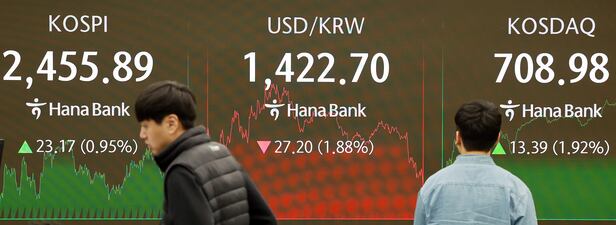The won-dollar exchange rate fell more than 25 won in a day, dropping to the 1,420 won level for the first time in four months. This decline is due to the fluctuating reciprocal tariff policy of U.S. President Donald Trump, which has impacted the value of the dollar.
On the 14th, the weekly closing price of the won-dollar exchange rate in the Seoul foreign exchange market, as of 3:30 p.m., recorded a decline of 25.8 won, closing at 1,424.1 won. This is the lowest level in four months since December 6, 2024, when it was 1,419.2 won.

The exchange rate, which started trading at 1,428 won on that day, widened its decline, temporarily dropping to 1,423.8 won at one point during the trading session. It briefly rose back to the 1,430 won level but fell again to the 1,420 won range in the afternoon.
Amid the confusion surrounding Trump’s tariff policy, the volatility of the exchange rate has increased. Over the past week, the exchange rate fluctuated more than 60 won from the 1,420 won range to 1,480 won, marking the largest movement since trading hours in the Seoul foreign exchange market were extended to 2 a.m. last July.
This time, the exchange rate fell in response to the weak dollar. According to Investing.com, as of 4:16 p.m. the dollar was at a value of 99.27 against the currencies of six major countries. The dollar index has increased its decline since falling below 100 on the 11th, marking the first time the index has been below 100 since April 2022.
The weak dollar is a result of the uncertainty surrounding tariffs from the Trump administration, which has dampened consumer sentiment in the U.S. The April Michigan Consumer Sentiment Index recorded a significant drop to 50.8, down from 57.0 the previous month, falling short of market expectations. With declining consumer sentiment, concerns about inflation have surged. Respondents estimated the inflation rate for the next year at 6.7%, the highest since November 1981.
Investor sentiment, which had previously sought safety in the dollar, is now shifting toward the yen and euro. The dollar-yen exchange rate decreased from the 150 yen range at the end of last month to the recent 142 yen range. The euro-dollar exchange rate also recorded around $1.14, the highest level in over three years.
Jeon Kyoo-yeon, an economist at Hana Securities, noted, "Despite past periods of poor U.S. economic performance, the demand for safe assets has kept the U.S. dollar strong; however, the current hostile stance of the U.S. towards its traditional allies has increased uncertainty, resulting in a weakening preference for the U.S. dollar."
Park Sang-hyun, a researcher at iM Securities, stated, "The phenomenon of a weak dollar due to the continued confusion surrounding reciprocal tariffs is expected to continue for the time being," adding, "If the U.S. Treasury's exchange rate report expected to be released in April contains demands for appreciation against major currencies, it could lead to further strengthening of the euro and yen."